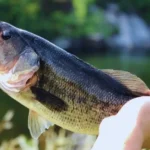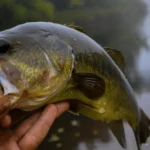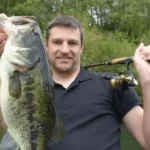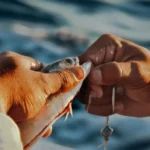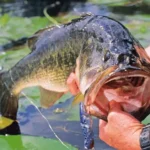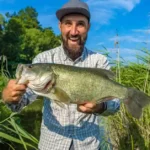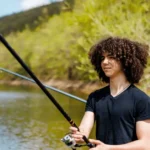Do you want to know how to catch more bass during the dog days of summer? In this comprehensive tutorial, we’ll discuss How to Catch Bass in Summer in great detail, providing you with all the knowledge you need to successfully reel in those evasive Fish. If you want to learn how to catch more bass this summer, or if you’re a newbie who wants to reel in their first large catch, How to catch bass in summer is the book for you. Let’s get started with how to catch bass in summer and make this summer one for the books!

The Seasonal Shift in Bass Habits
Bass behaviour changes dramatically when the summer sun shines, and temperatures increase. Any fisherman hoping to haul in a large catch this summer would do well to familiarize themselves with how these changes affect the behaviour of their target species.
Factors Influencing Bass Activity
There are a number of important summertime elements that affect bass activity. Let’s explore each one in detail to learn more about the impact they have on the habits of this evasive Fish.
Temperature
In the summer, water temperature is one of the most important elements influencing bass activity. Bass becomes more active when the water temperature rises. Their metabolism speeds up in the warmer water, driving them to actively seek prey.
But it’s important to remember that too much heat may be dangerous, too. When water temperatures rise too high, the bass may become less active or go to deeper water in search of cooler temperatures. If you want to catch more bass this summer, you need to know what temperature range is best for the bass where you live.
Water Depth
In the summer, bass concentrations are strongly influenced by water depth. Bass swim deeper away from the heat of the day. They like to be in the depths during the hot summer because the air is more consistent and chilly.
Use sonar or fishfinders to detect these deeper spots during summer bass fishing. Bass looking for shade in the summer may often be found around structures such as underwater rock formations, ledges, and drop-offs.
Time of Day
Time of day, like in other seasons, may have a significant effect on bass activity. The optimum times of day to go bass fishing tend to be early in the morning and late in the afternoon throughout the summer. Bass are more likely to be active and eat during these chilly hours.
Bass are usually less active in the middle of the day when the sun is at its highest, and they may even go into deeper cover. You can still catch them at these times, but you’ll have to be patient and modify your fishing strategy.
Food Sources
Knowing what bass eat in the summer is essential for catching them. Bass at this time of year eat anything from tiny Fish and insects to crayfish. Bass anglers have had great success using topwater lures, crankbaits, and soft plastic baits that imitate these prey items.
It’s important to remember that your fishing spot’s accessibility to various food sources may vary. Finding the correct lures and bait might be a lot easier if you study the local prey species and their tendencies.
Essential Gear for Summer Bass Fishing
Having the proper equipment might be the difference between a fun day on the lake and a tedious one while bass fishing in the summer. Let’s talk about what gear is necessary to catch more of those elusive summer bass.
Rods and Reels
In the summer, bass fishing is at its peak. Therefore, it’s crucial to have the correct rod and reel. Larger bass and the thicker cover that is common in the summer need for rods with a medium-heavy to heavy-action. Use a baitcasting reel with your rod to increase your precision and control, or go with a high-quality spinning reel for more options and less hassle.
Line Selection
Selecting the correct fishing line is essential. Bass are more active and may make longer runs in the summer, so a strong rope is necessary. Lines with a 12-20lb test, whether monofilament or fluorocarbon, are great options since they are strong enough to fight large Fish but pliable enough to cast.
Tackle and Baits
- Topwater Lures: The topwater season peaks in the summer. Purchase a wide array of topwater lures to increase your chances of catching Fish. The disturbance they cause on the water’s surface sometimes leads to violent attacks from predatory bass.
- Soft Plastics: Bass fishermen almost always have some kind of soft plastic bait, such as worms, creature baits, or swimbaits. They are able to imitate a wide variety of natural prey and may be modified to perform in a variety of environments.
- Crankbaits: Covering water and finding schools of aggressive bass are two of the best uses for crankbaits. Choose crankbaits with varying depth profiles, such as those with a shallow and medium profile. The jiggling motion of these lures may attract strikes from even the most timid Fish.
- Jigs: Jigs may be used in many contexts and are pretty successful when they are. Jigs with corresponding trailers may simulate crawfish and other bottom-dwelling prey when flipped through thick cover or probed in deep structures.
Electronics and Fish Finders
The way we Fish has been transformed by technology. If you want to catch bass, you may want to invest in a fish finder or sonar equipment, particularly in the summer when they could be lurking in deeper water to avoid the heat. These gadgets are invaluable for locating structure, bait, and the sweet spots to cast your lures.
In addition, a high-quality GPS device might be helpful for identifying fruitful places so that you can quickly revisit them in the future. This is especially helpful during the summer months when bass are more active and have a stronger affinity for specific underwater structures and shapes.
Locating Summer Bass
During the summer, locating bass might seem like looking for a needle in a haystack, but you can improve your chances of success by arming yourself with the correct information. Here, we’ll discuss where to look for summer bass and what they like to use for shelter.
Shallow Water Hotspots
Bass tend to migrate to deeper water throughout the summer, but there are situations in which you might find them in shallower waters.
- Shaded Areas: Choose a place naturally shaded by trees, grass, or lily pads. These shady spots not only give comfort from the sun but also excellent vantage points from which bass may attack unsuspecting victims.
- Early and Late: During the morning and evening, when the water is colder, bass may swim closer to shore. They are more likely to go into shallower waters to feed at this period.
Deep Water Hideouts
When temperatures rise throughout the summer, bass seek refuge in deeper water. You may usually find them at these locations:
- Drop-offs and Ledges: Bass finds shelter in the stability of drop-offs and ledges, which enable them to scout shallower regions while maintaining easy access to deeper water. Learn what they are by using sonar or a fish finder.
- Thermoclines: A thermocline, or temperature boundary, develops in the summer in some lakes. There are two possible thermal comfort zones for bass: slightly above and below the thermocline.
Structure and Cover
Basses are well-known for their penchant for hiding in and around structures. Knowing what they like and dislike about these features might be crucial:
- Vegetation: Bass thrive under the cover of aquatic vegetation like lily pads, hydrillas, and submerged grass. They congregate here during the hot summer months to escape the heat, plan ambushes, and cool down. If you want to go through the vegetation without being caught, you should try employing weedless lures and methods.
- Rocks and Ledges: Rocks and underwater ledges have a special significance for bass. These are great for hiding in and ambushing prey. Bass may be successfully targeted with crankbaits and jigs in these waters.
- Docks and Piers: Bass are attracted to man-made buildings like docks and piers because they provide shelter and a place to rest. During the middle of the day, when bass are seeking shade from the sun, pitching soft plastics or jigs beneath these structures may provide outstanding results.
Techniques for Summer Bass Fishing
The chances and difficulties of summer bass fishing are distinct. It’s important to have a wide range of fishing strategies at your disposal this time of year to maximize your chances of catching Fish. Some proven strategies for landing a summer bass:
Topwater Action
- Poppers and Chuggers: The disturbance caused by topwater poppers and chuggers might provoke aggressive strikes from summer bass. To trick your target into coming closer, use a popping or chugging motion in time with the water. Keep your casters close to cover and be ready for explosions.
- Buzzbaits: Topwater fishing is also great for using buzz baits. Vibrations and sounds from their spinning blades may be picked up by bass speakers. Keep them in touch with the water as you slowly retrieve them along the surface. These lures are typically met with ferocious strikes from bass.
Texas Rigging Soft Plastics
Bass anglers may offer soft plastic baits in a variety of ways using the Texas rigging method.
- Choose your preferred soft plastic, such as a worm or creature bait.
- Insert a bullet weight or worm weight into the nose of the appeal.
- Attach a worm hook, ensuring the hook point is hidden in the bait.
- Cast near cover or structure, and slowly drag the bait along the bottom. Pause intermittently to mimic natural movement.
Deep Diving Crankbait Retrieval
When fishing for bass in deeper water, deep-diving crankbaits are your best bet.
- Cast the crankbait to the desired depth.
- Retrieve the lure with a steady, medium-paced crank of the reel handle.
- Crankbaits dive deeper with longer casts and slower retrieves, so adjust your technique based on the water depth and bass location.
Jigging Techniques
Jigs are adaptable baits that may be used in many settings:
- Cast a jig near the structure or cover.
- Allow it to sink to the desired depth.
- Use a combination of hops, lifts, and pauses to imitate prey near the bottom.
Drop Shotting
Drop shooting is a delicate technique that may be used to catch summer bass that are suspended or elusive.
- Tie a drop shot hook with a leader line above a weight.
- Attach your soft plastic bait to the theme.
- Cast to the desired depth, then lift and shake the bait gently to entice the bass.
Carolina Rigging
When you need to cover a lot of water and deliver your baits close to the bottom, Carolina rigging is your best option.
- Use a Carolina rig setup with a bead, swivel, leader line, and your choice of soft plastic bait.
- Cast and drag the rig along the bottom, creating subtle vibrations to attract bass.
Flipping and Pitching
Precision tactics like flipping and pitching are essential for catching bass in dense cover.
- Use a short rod and heavy line for accuracy.
- Lower your bait quietly into pockets of cover, such as vegetation, docks, or submerged structures.
- Keep your line tight to feel for subtle strikes.
Presentation and Retrieval Tips
The difference between a nibble and a strike in bass fishing often comes down to how the lures are presented and retrieved. If you want a productive day on the water, here are some key pointers to help you perfect your presenting and retrieval methods.
Slow and Steady Wins the Race
A calm and steady retrieve is usually more efficient than a quick and erratic one when fishing for summer bass. Here’s why:
- Imitate Natural Movement: During the warmer summer, bass are less likely to actively pursue their prey. Injured Fish or lethargic food suffering in the heat are retrieved at slower speeds to closely replicate their natural behaviour.
- Keep Lures in the Strike Zone: With a slower retrieve, your lure will spend more time in the strike zone. This is especially true when fishing for bass under cover or structure.
- Trigger a Reaction: The bass’s predatory reaction might be triggered by a delayed presentation. When a lure is around for a long time, it may provoke an attack out of frustration or opportunism.
Mimicking Natural Prey
Summer bass may be tricked into biting by using bait that looks like nearby feed. How to Convincingly Imitate Their Natural Prey.
- Observe Local Prey: When fishing, it’s essential to know what kinds of baitfish, insects, and other aquatic organisms inhabit the area. With the goal of catching more bass, your lure should mimic the size, shape, and colour of food bass often consume.
- Match the Hatch: Choose lures that look like newly hatched insects or baitfish if you’ve seen a particular hatch. Bass often capitalize on these casual feeding situations.
- Use Realistic Colors: Pick lures with designs and colours that naturally occur in the area. When swimming in clear water, muted tones are preferable, but when visibility is low, brighter or contrasting colours are the way to go.
Adding Variations to Your Retrieval
If you want to catch more bass, try switching up your retrieve.
- Start-Stop: Try simulating an injured or frightened prey item by pausing your retrieval at random intervals. When a bass spots vulnerable prey during this break, they are more likely to attack.
- Change Speed: Even while doing a sluggish retrieve, it is beneficial to switch things up every so often. Rapid acceleration may help you blend in with the background and fool your victim.
- Twitch and Jerk: When retrieving a soft plastic, try out several twitches and jerks to see what works best. These jerky actions might serve as a disguise, making the prey seem hurt or alarmed.
Mastering the Pause
It’s impossible to stress the importance of pausing while fishing for summer bass:
- Mind the Timing: Be mindful of how long your lure sits when you pause. An instantaneous pause might be enough at times, while a longer one can be useful in others. Try different timings until you discover what works.
- Stay Alert: Prepare for attacks during the break when their victim is slow or defenceless. Bass frequently attack.
- Try Different Depths: Try pausing your lure at different depths. While some bass will only bite on tricks that are floating in the air, others will only bite on baits that are resting on the bottom.
Handling Summer Bass
The health of the bass you capture is crucial to the longevity of the fishery. The health of these prized sportfish depends on careful treatment, especially during the hot summer months. Some recommendations for working with summer bass:
Proper Catch and Release Techniques
- Use Appropriate Gear: Pick tackle appropriate for the size of the Fish you want to catch. Fish might be hurt or tired from fighting off heavy tackle.
- Avoid Overplaying: Conquer the bass with as little strain on yourself as possible. Weaker from exhaustion, a fish has a lower chance of surviving after being released.
- Handle Gently: If you want to avoid damaging the bass’s slime covering when handling it, wet your hands beforehand. Don’t squeeze or hold them too firmly, or you can cause internal damage.
- Use Barbless Hooks: Fish mouths are less damaged by barbless hooks, and they’re much simpler to remove. If you must use barbed hooks, crimping the barbs will make eliminating the curves far less dangerous.
- Practice Quick Release: Reduce the time the Fish is out of water as much as possible. Take the time to carefully remove the hook and then release the Fish. Get your camera ready ahead of time if you want to take a picture.
- Revive Exhausted Fish: If the bass seems fatigued after the battle, support its body gently in the water and let it swim away on its own. Before releasing it, be sure it has completely healed.
Keeping Bass Alive in Hot Weather
- Use Proper Equipment: To preserve your bass catch in prime condition, get a live or an aerated cooler. It’s best practice to keep the live water at the same temperature as the water where the Fish were captured.
- Limit Time in Livewell: Minimize the duration the bass spends in the livewell. The Fish in the lake might die if the temperature is too high.
- Monitor Water Temperature: To reduce stress on the Fish, you may want to limit your catch-and-release efforts during the warmest portions of the day if the water temperature is unusually high.
- Aerate and Add Ice: An aerator for life should be used whenever practical. Fish stress may be reduced by lowering the water temperature in the live well with the use of ice or frozen water bottles.
Ethical Fishing Practices
- Know the Regulations: Familiarize with local fishing regulations, including size and bag limits. Adhering to these rules ensures sustainable fishing practices.
- Respect Habitat: Avoid disturbing aquatic vegetation, nesting areas, and underwater structures. Protecting the Fish’s habitat contributes to the overall health of the ecosystem.
- Dispose of Trash Responsibly: Properly dispose of all fishing-related waste, including fishing lines, plastic baits, and packaging materials. These items can harm wildlife and aquatic life.
- Educate Others: Share your knowledge of ethical fishing practices with fellow anglers. Encourage responsible behaviour on the water to help conserve bass populations for future generations.
Strategies for Different Times of the Day
Bass behaviour and, by extension, fishing success are profoundly affected by the time of day. Suppose you know how bass activity shifts from morning to evening; you may tailor your tactics to maximize your chances of success. Let’s have a look at strategies for each time of day:
Early Morning Tactics
- Topwater Lures: Early mornings are prime time for topwater action. Bass are often more active near the surface during the cooler dawn hours. Use poppers, buzz baits, or walking baits to create surface commotion and trigger strikes.
- Shallow Water: As the sun rises, the bass often moves to shallower waters to feed. Target areas near shorelines, especially if there’s cover or structure, such as submerged grass or docks. Soft plastics and jerk baits can be effective in these conditions.
- Slow Presentation: In the early morning, a slower presentation can be more effective. Bass may still be sluggish from the cooler night temperatures, so work your lures patiently to entice strikes.
Midday Challenges and Solutions
- Seek Shade and Structure: As the sun climbs higher, bass retreat to deeper waters or seek shade and cover to escape the heat. Target submerged structures, drop-offs, and shady spots, such as overhanging trees or docks.
- Deep Diving Crankbaits: Deep diving crankbaits can be effective for reaching bass in deeper waters during midday. Vary your retrieval speed to find the bass’s preferred pace.
- Finesse Techniques: Switch to finesse techniques like drop shooting or Carolina rigging in clear, sunny conditions. These methods can help you tempt reluctant bass into biting.
- Stay Hydrated: Remember that the midday sun can be punishing, not just for bass but for anglers too. Stay hydrated, wear sunscreen, and take breaks to avoid heat exhaustion.
Evening Bass Bites
- Transition Period: Late afternoon and early evening can be a transition period as the sun starts to descend. Bass may become more active again as the water cools slightly.
- Target Shallow Areas: Return to shallower areas with vegetation and structure. Bass may move closer to shorelines to feed as the day’s heat subsides.
- Spinnerbaits and Soft Plastics: Spinnerbaits and soft plastics, such as worms or creature baits, can be effective in the evening. Try slow-rolling spinnerbaits through shallow cover or working soft plastics along the bottom.
- Be Prepared for Twilight: As the light fades, be prepared for a potential increase in bass activity during the twilight hours. Adjust your lures and presentations accordingly, as bass may become more aggressive.
Adapting to Changing Weather Conditions
The weather has a significant influence on bass behaviour and may make or break your day on the water. You need to be able to catch bass in every kind of weather, whether it’s hot and sunny, cloudy and rainy, or windy. Let’s talk about what to do in every possible situation:
Dealing with Hot and Sunny Days
When bass fishing, hot, bright days may be both difficult and fruitful.
- Seek Shade and Structure: Bass often seek shade and cover to escape the intense sun. Look for areas with overhanging trees, submerged vegetation, or docks. These shaded spots are prime locations for bass to hide and ambush prey.
- Fish Deeper Waters: In scorching weather, bass may retreat to deeper waters to find cooler temperatures. Use your fishfinder or sonar to locate thermoclines or drop-offs, and target these areas with deep-diving lures and slow presentations.
- Topwater During Low Light: Early morning and late evening, when the sun is less intense, can still offer topwater action. Use poppers, buzz baits, or walking baits during these low-light periods to entice bass near the surface.
Overcast and Rainy Days
Overcast and rainy conditions can be favourable for bass fishing:
- Topwater Lures: Overcast skies reduce light penetration, making bass less wary. This is an excellent time for topwater lures, as bass may be more willing to strike on the surface. Experiment with different topwater presentations to find what works best.
- Stay Shallow: Overcast days encourage bass to move closer to the surface. Target shallow areas, especially those with cover and structure, where bass may be actively feeding.
- Use Vibrant Colors: Bright and vibrant lure colours can stand out against the muted backdrop of overcast skies and water. Try chartreuse, fire tiger, or other high-visibility colours.
Windy Conditions
Windy days can present challenges but also create opportunities for bass fishing:
- Target Windy Points: Wind pushes baitfish and insects to windblown points, making them attractive to bass. Cast into the wind and work your lures along these areas where bass are likely to be waiting.
- Choppy Water: Wind creates surface disturbance, which can provide cover for your approach. Bass are often less cautious in choppy water, so use this to your advantage with topwater lures or aggressive retrieval techniques.
- Heavy Lures: Wind can affect the accuracy and distance of your casts. Consider using heavier lures to combat the wind and reach your target areas more effectively.
Summer Bass Fishing in Various Water Bodies
Bass fishing in the summer is enjoyable in many different bodies of water, each with its own set of difficulties and rewards. Let’s talk about several techniques for capturing bass in large quantities of water like lakes and reservoirs, as well as smaller bodies of water like rivers, streams and ponds:
Lakes and Reservoirs
- Locate Deep Structures: In larger bodies of water like lakes and reservoirs, bass tend to move to deeper structures as the summer progresses. Use your fishfinder to locate underwater ledges, drop-offs, and points. These are ideal places to find bass during the heat of summer.
- Cover Vast Areas: Larger water bodies require covering more ground. Consider using a boat or kayak to access different areas and explore a variety of depths and structures. Trolling with deep-diving crankbaits or spinnerbaits can help you search for active bass.
- Night Fishing: Summer nights offer excellent bass fishing opportunities in lakes and reservoirs. Bass often move to shallower waters to feed under the cover of darkness. Topwater lures and soft plastics can be highly effective during nighttime outings.
Rivers and Streams
- Focus on Current Breaks: In rivers and streams, bass seek refuge from strong currents. Look for current breaks created by rocks, logs, or bends in the river. These are prime locations for bass to ambush prey.
- Use Natural Presentation: Rivers and streams often have clear water, making the bass more cautious. Opt for more natural-looking lures and finesse techniques. Soft plastic worms, crawfish imitations, and small jigs can work well.
- Understand Seasonal Movement: River bass can move up and downstream with changing water temperatures and food availability. Pay attention to the seasonal patterns of bass in your specific river or stream.
Ponds and Small Bodies of Water
- Explore Shallow Areas: Ponds and small bodies of water can heat up quickly during the summer, pushing bass into shallower areas. Target areas with submerged vegetation, lily pads, or overhanging trees and cast near these cover-rich spots.
- Adapt to Limited Space: Fishing in small bodies of water may not require a boat. You can effectively fish from the shore or a small kayak or canoe. This can make for a more intimate and enjoyable experience.
- Use Light Tackle: In smaller waters, lighter tackle and finesse techniques can be highly effective. Try using spinning gear with light lines and smaller lures like soft plastics or small crankbaits.
- Pay Attention to Water Quality: Ponds and small lakes may experience water quality changes more rapidly than larger bodies of water. Be mindful of water clarity and temperature, as these influence bass behaviour.
Tournament Tactics for Summer Bass Fishing
Summer bass fishing tournaments may be thrilling, but they also need meticulous preparation, pinpoint execution, and the capacity to improvise in the face of uncertainty. If you want to win the competition, here are some strategies to consider:
Planning and Pre-fishing
- Scouting the Waters: Before the tournament, spend time exploring the tournament waters. Familiarize yourself with the layout, structures, and potential hotspots. Note any changes in water conditions, such as temperature and clarity.
- Target Selection: Identify several potential fishing spots based on your pre-fishing observations. Have backup options in case your primary areas aren’t producing on tournament day.
- Fine-tuning Techniques: Based on your scouting, select the lures and techniques most likely to work on tournament day. Be prepared to switch tactics if conditions change.
- Prepare Tackle and Equipment: Organize your tackle box, ensure your rods and reels are in top condition, and have spare equipment ready. Check your boat’s functionality, including the live for keeping Fish alive.
Tournament Day Strategies
- Time Management: On tournament day, time management is crucial. Stick to a schedule, allocating specific times for each fishing spot. Don’t linger too long in unproductive areas.
- Stay Adaptable: Bass can be unpredictable, especially during tournaments. If your initial plan isn’t working, be ready to switch tactics, locations, or lures. Stay adaptable and open to changes.
- Fish Comfort Zones: Focus on the comfort zones of bass, especially in summer. Target shady spots, cover, and deeper areas where bass are likely to find cooler water and ambush prey.
- Mind the Livewell: Ensure the livewell is functioning correctly to keep your Fish alive. Keep an eye on the condition of your catch, and cull smaller Fish if necessary to maintain a live well limit.
- Manage Stress: Tournament fishing can be stressful. Stay calm, make decisions based on your pre-fishing knowledge, and avoid panicking if things don’t go as planned. Keep a positive mindset to stay focused.
Handling Pressure Situations
- Pressure from Competitors: Don’t let the presence of other anglers affect your strategy. Stay committed to your plan and tactics, and avoid being swayed by the actions of competitors.
- Pressure from the Clock: With limited time in a tournament, it’s easy to feel rushed. Stick to your schedule, but also trust your instincts. A last-minute decision could lead to a winning catch.
- Maintain Confidence: Believe in your abilities as an angler. Confidence in your chosen techniques and spots can make a significant difference when the pressure is on.
- Post-fishing Analysis: After the tournament, reflect on your performance. Analyze what worked and what didn’t. Use this knowledge to improve your strategies for future games.
Summer Bass Fishing Safety
Summer bass fishing may be a lot of fun, but it’s important to take precautions, particularly while out in the sun for extended periods. Some fundamental safety considerations are as follows:
Sun Protection
- Wear Sunscreen: Apply a broad-spectrum sunscreen with a high SPF rating before heading out on the water. Reapply sunscreen throughout the day, especially after swimming or sweating.
- Protective Clothing: Wear lightweight, long-sleeved shirts, wide-brimmed hats, and sunglasses with UV protection. These items provide additional protection against harmful UV rays.
- Seek Shade: Whenever possible, take breaks in the shade to prevent overexposure to the sun. Heat-related illnesses like heat exhaustion and heatstroke can be a real danger in the summer.
Hydration
- Drink water Regularly: Dehydration is a significant concern during hot summer days. Bring an adequate supply of water and drink regularly to stay hydrated. Avoid alcohol and excessive caffeine, as they can contribute to dehydration.
- Electrolyte Replacement: Consider carrying electrolyte replacement drinks or supplements to replenish essential minerals lost through sweating. This can help maintain your energy and prevent cramps.
- Recognize Signs of Heat-related Illness: Be aware of the symptoms of heat-related illnesses, including dizziness, nausea, confusion, rapid heartbeat, and excessive sweating. If you or anyone in your group experiences these symptoms, seek shade and hydrate immediately.
Boat and Equipment Safety
- Life Jackets: Always wear a properly fitted U.S. Coast Guard-approved life jacket while on the boat. Make sure everyone on board has a life jacket as well.
- Emergency Equipment: Ensure your boat is equipped with safety equipment, including a fire extinguisher, first-aid kit, whistle, and throwable flotation device. Familiarize yourself with their locations and use.
- Boat Maintenance: Regularly maintain your boat’s engine, electrical systems, and safety equipment. Check for any signs of wear or damage before each outing.
- Weather Awareness: Keep an eye on the weather forecast before and during your fishing trip. Sudden storms can pose a significant safety risk on the water.
- Boating Etiquette: Follow boating rules, including speed limits, no-wake zones, and safe distance from other boaters.
- Float Plan: Inform someone trustworthy about your fishing plans, including your location, expected return time, and emergency contact numbers. This can be crucial in case of an emergency.
- Stay Balanced: When casting or moving around on the boat, maintain a low centre of gravity and be cautious to prevent falling overboard.
- Respect Local Regulations: Familiarize yourself with local boating and fishing regulations, including fishing licenses, size and bag limits, and no-fishing zones.
Conservation and Responsible Fishing
Bass populations and the ecosystems they are a part of depend critical ly on conservation efforts and appropriate fishing methods. We have a duty as fishermento safeguard these treasures for future generations. For better conservation and fishing practices, consider these two factors:
Protecting Bass Habitat
- Preserve Vegetation: Aquatic vegetation is vital for the health of bass populations. It provides cover for young Fish, supports the food chain, and contributes to water quality. Avoid disturbing or damaging aquatic vegetation when fishing.
- Respect Spawning Grounds: During the spawning season, bass create nests or beds to lay their eggs. These areas are crucial for the survival of young bass. Avoid fishing in or disturbing known spawning grounds to ensure the next generation of bass has a chance to thrive.
- Dispose of Trash Properly: Dispose of trash, fishing lines, and plastic baits responsibly. These items can harm wildlife and aquatic life if left in the water. Use designated receptacles or take your trash with you.
- Practice Ethical Boating: When boating, be mindful of the wake you create. Excessive wake can erode shorelines, disturb nests, and damage aquatic vegetation. Follow no-wake zones and reduce your speed in sensitive areas.
Catch and Release Initiatives
- Catch and Release Education: Educate yourself and fellow anglers about catch and release practices. Promote the importance of releasing undersized or trophy-sized bass to maintain healthy populations.
- Handle Fish Carefully: When handling Fish, wet your hands to avoid removing the protective slime layer. Hold Fish gently, support their body, and avoid squeezing or dropping them. Minimize the time the Fish spends out of the water.
- Use Proper Tools: Carry the tools for safe hook removal, such as pliers or forceps. Use barbless hooks or crimp-down barbs to make hook removal easier and less damaging to the Fish.
- Practice Selective Harvest: If you decide to keep Fish for consumption, adhere to size and bag limits, and consider practising selective harvest by releasing larger breeding fish to maintain genetic diversity.
- Revive Exhausted Fish: If a bass appears tired after a fight, hold it gently in the water, supporting its body, until it regains its strength and swims away under its power.
- Follow Regulations: Familiarize yourself with local fishing regulations, including size and bag limits. Respect these limits to ensure sustainable bass populations.
Success Stories and Expert Tips
Successes and remarkable catches abound in the sport of bass fishing. Here, we’ll discuss some of the most noteworthy captures ever made, as well as some advice from professional fishermen.
Pro Angler Insights
- Kevin VanDam’s Wisdom: Kevin VanDam, one of the most successful bass anglers in history, emphasizes the importance of versatility. He suggests mastering various techniques to adapt to changing conditions and maximize your chances of success.
- Mike Iaconelli’s Passion: Mike Iaconelli, known for his boundless enthusiasm for fishing, emphasizes the role of passion in your angling journey. His advice is to enjoy every moment on the water, whether you catch Fish or not, as it’s the love for the sport that keeps you coming back.
- Gerald Swindle’s Adaptability: Gerald Swindle, a versatile angler with numerous wins, stresses the need to adapt to the Fish’s preferences. He recommends switching lures, colours, and techniques until you find what the bass is biting on.
- Scott Martin’s Preparation: Scott Martin, a seasoned tournament angler, emphasizes preparation. He advises studying maps, scouting locations, and understanding seasonal patterns to increase your chances of success.
Notable Catches
- The World Record Largemouth Bass: George Perry’s legendary catch in 1932 still holds the record for the heaviest largemouth bass ever caught. His 22-pound, 4-ounce bass is a testament to the potential for giant bass in the waters.
- The “Double Digit” Club: Anglers who have caught bass weighing over 10 pounds join the prestigious “double-digit” club. These catches inspire anglers to seek out trophy bass and put in the time and effort needed to land these giants.
- The Bassmaster Classic Victories: The Bassmaster Classic is the most prestigious tournament in bass fishing. Legendary anglers like Rick Clunn, Roland Martin, and Kevin VanDam have multiple Classic victories, showcasing their exceptional skills.
- Local Legends: Not all inspiring catches make it into the record books. Local anglers often have their own legendary stories of trophy bass. These catches remind us that big bass can be found in unexpected places.
How To Catch Bass in Summer: FAQs
What baits work best for summer bass fishing?
Bass anglers often find the most success using plastic worms, crankbaits, and topwater lures during the summer months. Find the ideal lure size, colour, and retrieval method for your fishing spot via trial and error.
When should I fish for bass in the summer?
In the summer, bass fishing is best in the early morning and late evening, when the bass are most active. They are often taken at night but may be captured during the day around shady regions and submerged structures.
What colours do bass prefer?
Bass have been caught on a wide range of lure colours, but natural tones like green, brown, and black are safe bets. When choosing lure colours, it is also essential to think about the visibility of the water and the available lighting.
How can I catch more bass?
To catch more bass in the summer, throw near cover like foliage, docks, or submerged rocks. Bass are picky eaters, so you may need to experiment with various retrieving methods and be patient.
When is the ideal time to catch bass?
Early morning and late evening, when water temperatures are lower, are the best times to capture bass throughout the summer. But by adapting your techniques throughout the day, you can catch bass whenever you choose.
Final Thought
Finally, catching bass in summer may be fun and rewarding for every fisherman. You may improve your fishing success by studying bass’s summer behaviours. Knowledge, patience, and the appropriate approaches are your greatest friends for summer bass fishing. Accept the challenge and enjoy summer bass fishing!


